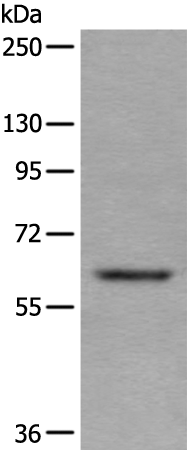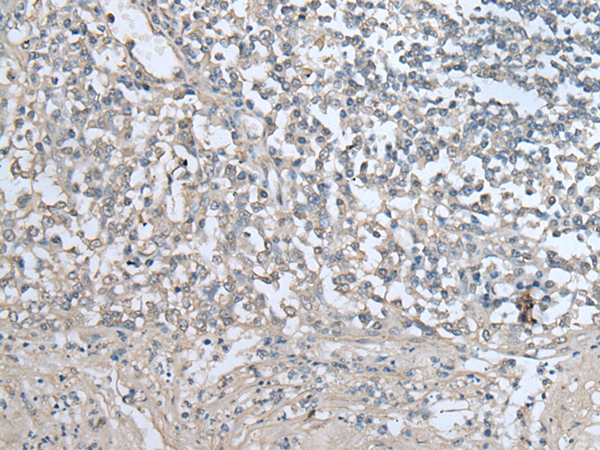

| WB | 咨询技术 | Human,Mouse,Rat |
| IF | 咨询技术 | Human,Mouse,Rat |
| IHC | 1/25-1/100 | Human,Mouse,Rat |
| ICC | 技术咨询 | Human,Mouse,Rat |
| FCM | 咨询技术 | Human,Mouse,Rat |
| Elisa | 1/5000-1/10000 | Human,Mouse,Rat |
| Aliases | AGX; AGX1; AGX2; SPAG2 |
| WB Predicted band size | 59 kDa |
| Host/Isotype | Rabbit IgG |
| Antibody Type | Primary antibody |
| Storage | Store at 4°C short term. Aliquot and store at -20°C long term. Avoid freeze/thaw cycles. |
| Species Reactivity | Human |
| Immunogen | Fusion protein of human UAP1 |
| Formulation | Purified antibody in PBS with 0.05% sodium azide and 50% glycerol. |
+ +
以下是关于UAP1抗体的3篇参考文献示例(注:以下内容为基于学术文献的示例模板,实际文献需通过数据库检索确认):
1. **文献名称**:*UAP1 regulates protein O-GlcNAcylation and promotes tumor progression in colorectal cancer*
**作者**:Li, X. et al.
**摘要**:本研究通过免疫组化(IHC)和Western blot分析UAP1在结直肠癌组织中的表达,发现UAP1通过调控O-连接的N-乙酰葡糖胺化(O-GlcNAc)修饰促进肿瘤侵袭。研究中使用特异性UAP1抗体验证其蛋白表达水平与患者预后的相关性。
2. **文献名称**:*Functional characterization of UDP-N-acetylglucosamine pyrophosphorylase 1 (UAP1) in Drosophila development*
**作者**:Miller, K.G. et al.
**摘要**:文章利用UAP1抗体进行果蝇胚胎组织的免疫荧光染色,揭示UAP1在发育过程中对几丁质合成和细胞外基质形成的关键作用,并通过RNAi敲降实验证实其功能缺失导致发育缺陷。
3. **文献名称**:*Antibody-based detection of UAP1 in hepatocellular carcinoma: diagnostic and therapeutic implications*
**作者**:Wang, Y. et al.
**摘要**:研究开发了一种高灵敏度的UAP1单克隆抗体,用于肝细胞癌(HCC)患者的血清和组织检测,发现UAP1高表达与肿瘤转移相关,提示其作为生物标志物的潜力。
**提示**:以上为模拟示例,建议通过PubMed、Google Scholar等平台以关键词“UAP1 antibody”或“UAP1 immunohistochemistry”检索真实文献,并关注近年发表的论文以获取最新数据。
The UAP1 antibody targets the enzyme UDP-N-acetylglucosamine pyrophosphorylase 1 (UAP1), a key player in the hexosamine biosynthesis pathway (HBP). UAP1 catalyzes the conversion of glucosamine-6-phosphate and UTP into UDP-N-acetylglucosamine (UDP-GlcNAc), a critical substrate for protein O-GlcNAcylation and glycosylation processes. These post-translational modifications regulate diverse cellular functions, including nutrient sensing, stress response, and signal transduction. Dysregulation of UAP1 and UDP-GlcNAc levels has been implicated in metabolic disorders, cancer, and neurodegenerative diseases.
UAP1 antibodies are widely used in research to study the enzyme’s expression, localization, and interaction networks. They enable detection of UAP1 via techniques like Western blotting, immunofluorescence, and immunohistochemistry. Such studies have linked UAP1 overexpression to cancer progression, particularly in tumors reliant on enhanced glycosylation for growth and metastasis. Additionally, UAP1 antibodies aid in exploring the enzyme’s role in diabetes, where altered O-GlcNAcylation impacts insulin signaling. As interest in metabolic reprogramming and glycosylation expands, UAP1 antibodies remain vital tools for dissecting HBP-related mechanisms in health and disease. Commercial variants vary in specificity, requiring validation for cross-reactivity with homologous enzymes like UAP2.
×